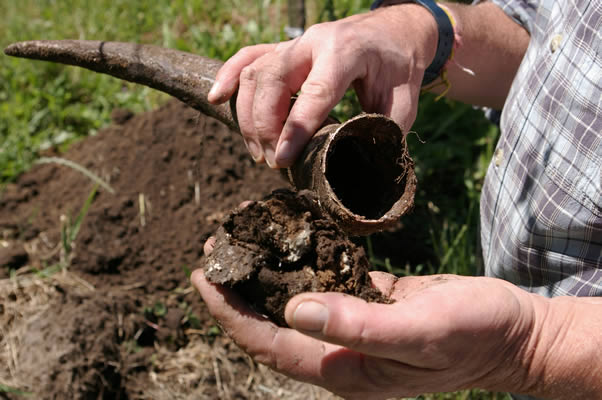|


Retrieving a biodynamic preparation
from a cow's horn that has been buried in the ground at Millton, New
Zealand
part
1: an introduction to biodynamics
This
is the first part of a major series exploring biodynamic wine
growing, which is a supercharged form of organics that is proving
increasingly popular. My hope is that this will represent a
thoughtful, critical and fair appraisal of this complicated and
rather controversial subject.
Back
in 1997, the sales team and directors of Corney & Barrow visited
Domaine Leflaive in Burgundy. Anne-Claude Leflaive poured them two
wines, blind, and asked them which they liked best. 12 out of the 13
preferred the same wine. What was the difference?
Well,
both were technically the same wine: her 1996 Puligny Montrachet 1er
Cru Clavoillon. But the wines were made from adjacent plots of
vines, one organic, the other farmed with biodynamics, an
alternative system of agriculture that represents the focus of this
new series. This latter wine was the one that the Corney &
Barrow team had singled out almost unanimously as their favourite.
The following vintage Domaine Leflaive went fully biodynamic.
Anecdotal
observations like these don’t constitute hard scientific data, but
they are common enough— and come from people making serious enough
wines—to merit proper attention. Indeed, the roll call of
biodynamic producers forms a star-studded list, and one that is
growing steadily.
The
goal of this new series is to capture the essence of biodynamic
viticulture, and answer some key questions. First, how does
biodynamics differ from conventional and organic agriculture? I’ll
explore the sorts of practices and philosophies that set biodynamic
practitioners apart from their peers.
Then
we’ll meet some of the people involved in biodynamics, including
Nicolas Joly, James Millton, Michel Chapoutier and Alvaro Espinoza.
A
crucial question is whether it actually works, and if so, how?
I’ll also address whether biodynamics can be reconciled with a
scientific understanding of viticulture.
Other topics in
this series
-
part
2, what is biodynamics?
-
part
3, who is doing it?
-
part
4, are you certifiable?
-
part
5, an audience with Nicolas Joly
-
part
6, Alvaro Espinoza, biodynamics in the new world
-
part
7, biodynamics in action - a visit with James Millton
-
part
8, the consultants
-
part
9, bringing together biodynamics and mainstream science
-
part
10, interview with Monty Waldin
Back
to top
|
